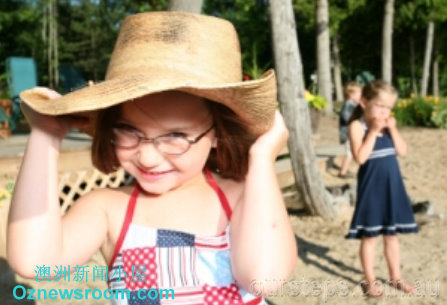|



|
此文章由 villa 原创或转贴,不代表本站立场和观点,版权归 oursteps.com.au 和作者 villa 所有!转贴必须注明作者、出处和本声明,并保持内容完整

据2009年1月7日《The Advertiser》报道,澳洲国家健康医疗研究中心一项研究显示,每天在户外两三个小时,可有助于少年儿童的眼睛发育,大幅降低罹患近视的几率。
这项研究的负责人Ian Morgan表示,近视一直是受过高等教育者的普遍现象,近视人口比例在东亚地区已创下历史最高纪录。在香港、台湾、日本、韩国及中国大陆,罹患近视的儿童已越来越多,多达90%的新加坡人在完成教育离开学校时已经是近视眼。
但是在澳洲,该项比率约为20%。这个现象耐人寻味,因为澳洲的教育也非常普及,但国民的近视比率却偏低。
一项比较研究显示,在新加坡,大约有30%6~7岁儿童已经出现近视的情形,同龄澳洲儿童的比率仅为1.3%。研究人员再拿新加坡和澳洲的华裔孩童做比较,发现结果相近,因此排除种族因素跟近视之间的关系。
其中最大的差别在于户外活动的时间长短。新加坡儿童每天平均在户外停留30分钟,澳洲孩子则是2个小时。两者在阅读、看电视、玩电脑游戏等方面花费的时间相差无几,因此也可破除电视电脑的闪烁屏幕有害儿童视力的传统观念。
 :si139 :si139

Peppe Page has some fun out-doors with a friend yesterday.
Sun helps bright eyes
January 07, 2009 12:01am Article from: The Advertiser
A DOSE of sunshine helps keep the eye doctor away, a study has shown.
Spending a couple of hours outdoors each day could help children avoid becoming short-sighted, Australian researchers said Tuesday.
Exposure to bright light for two to three hours daily helps regulate the eye's growth, dramatically reducing the risk of myopia, an Australian Research Council study found.
Short-sightedness, traditionally a problem among the highly educated, has reached record levels in east Asia, lead researcher Professor Ian Morgan said.
Growing numbers of children in Hong Kong, Taiwan, Japan, Korea and China are struggling with their vision, with up to 90 percent of Singaporeans wearing glasses by the time they leave school, he said.
"That would compare with about 20 percent of Australians. We were quite intrigued by this -- that for a country that's quite well educated we have a serious lack of myopia in Australia," Morgan said.
A comparative study showed 30 percent of six and seven-year-old Singaporean children had already developed the condition, compared with just 1.3 percent of Australians of the same age.
The figures were similar when contrasting children of Chinese descent from both nations, allowing researchers to eliminate ethnicity as a factor.
The one significant difference between the populations was time spent outdoors -- children from Singapore spent an average 30 minutes outside every day, compared with two hours for the average Australian.
Both groups spent about the same amount of time reading, watching television and playing computer games, debunking the theory that flickering screens were ruining children's eyes, he said.
"There's a driver for people to become myopic and that's education," Morgan said. "And there's a brake on people becoming myopic and that's people going outside."
"What we would suggest is that what's happened in east Asia is that they have got the balance totally out of kilter."
The study is part of a long-term project on eyesight at the government-funded council.
Marshmallow Park is a favourite for students from nearby Pulteney Grammar School.
Peppe, 6, of Torrens Park, says it is "really fun".
However, his mother, Narelle Page, 38, says Peppe has to be encouraged to play outside. "It has been an effort to make him play," she said. |
评分
-
查看全部评分
|
 简单菜 简单爱--潮味:(潮州菜里的乡愁)之荷兰薯(土豆)粿 (2013-10-20) xhioanog
简单菜 简单爱--潮味:(潮州菜里的乡愁)之荷兰薯(土豆)粿 (2013-10-20) xhioanog  读书一小时 - 2011读书笔记 (2011-6-8) 老猫晒太阳
读书一小时 - 2011读书笔记 (2011-6-8) 老猫晒太阳  临时残障人士 (2006-10-14) susan
临时残障人士 (2006-10-14) susan  10日 环游 新西兰南岛 游记 (更新到第10天,全文结束!) (2009-11-12) JackZhang
10日 环游 新西兰南岛 游记 (更新到第10天,全文结束!) (2009-11-12) JackZhang